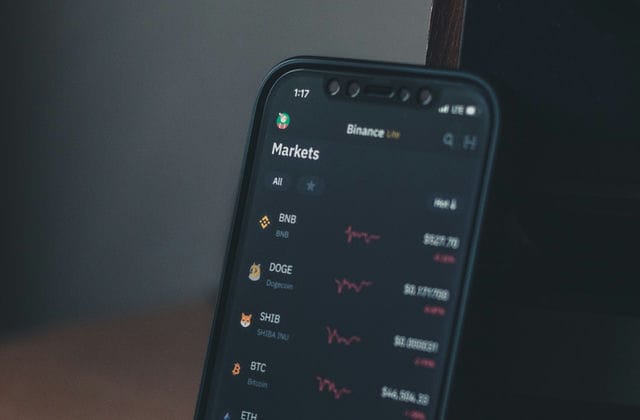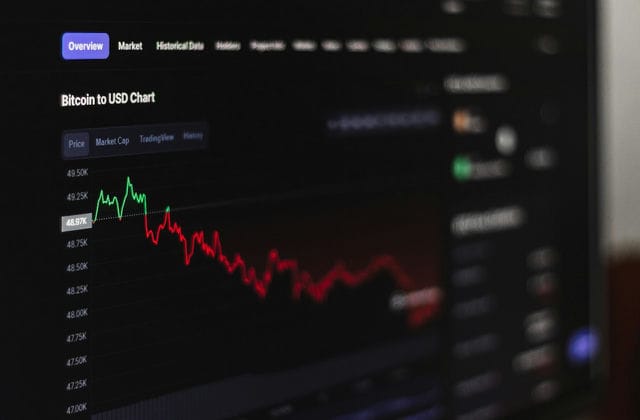Looking back, since the 1900s, there have been several financial crisis events in history. In a globalized economy, where industry chains are interlinked, a major stock market crash can easily affect the economic development of several countries.
What is a stock market crash?
A stock market crash is usually unannounced and devastating, and tends to occur after an economic bubble has been created by massive speculation in the market, accompanied by a sudden and dramatic fall in stock prices over a short period of time.

Most of the financial crises that have occurred in history have had a serious impact on national economies, with business failures, rising unemployment, capital outflows, currency devaluations and heavy losses for investors in the market occurring one after another.
Taking stock of historical financial crisis events
The US stock market crash of 1929
The 1973 oil crisis
1987 Black Monday
1997 Asian Financial Crisis
2000 dot-com bubble
2008 Financial Tsunami
2010 European Debt Crisis
2020 New Coronary Pneumonia sweeps the world
The US stock market crash of 1929
The 1920s was a boom time in the United States, also known as the 'Roaring Twenties'. The economy was growing rapidly, the stock market was bullish and reaching record highs, many investors even took out loans to invest in the stock market, and the culture was so strong that most people ignored risk. It was not until the Wall Street crash of 1929 that the Great Depression brought years of hardship to the world.
Impact.
The day of 28 October 1929 was the famous 'Black Monday' in history, kicking off a decade of economic depression. Shortly after the market opened that day, the Dow Jones fell sharply, dropping by as much as 12.82%. The next day, 29 October, the Dow continued to fall, by as much as 11.73%.
After the crash, the US economy was in crisis and unemployment was rapidly climbing. Workers lost their jobs; businesses went bankrupt and banks collapsed. By 1933, the unemployment rate was as high as 25%. In other words, 1 in 4 people were unemployed.
The stock market continued to suffer for three years before coming to an end in July 1932. The collapse, which came without warning, completely shattered investors' confidence and it was not until 1954 that economic standards gradually returned to those of 1929.
The 1973 oil crisis
Oil is the mother of industry, not only for cars, planes and ships, but also for plastics, rubber and cosmetics in everyday life.
From 1950 to 1973, a consortium of seven major companies, including Shell, Texaco, Standard Oil, Gulf Oil, Persian Oil, Exxon and Mobil Oil, monopolized the oil market, driving down the price of crude oil to an average of US$1.80 per barrel.
The low prices sparked discontent among the oil-producing countries, and with the outbreak of the Middle East War in October 1973, the oil-producing countries, in retaliation for the Western countries' aid to Israel, therefore decided to reduce oil production, raise oil prices and impose an oil embargo on the Western countries as a means of retaliation.
Impact.
The Fourth Middle East War broke out in October 1973 when Egypt attacked Israel, and this war triggered the first oil crisis that lasted from 1973 to 1974.
The Organization of the Petroleum Exporting Countries (OPEC) decided to retaliate against Israel and the countries that supported it by reducing oil production, raising oil prices and imposing an oil embargo on the West.
At the time, most capitalist countries relied on imported oil, and before the oil price increase, the price per barrel was US$3.01. By the end of 1973, however, the price of oil had risen to US$11.60 per barrel, a nearly fourfold increase, which had a dramatic impact on countries and led to a serious economic crisis.
The rapid rise in oil prices, combined with the effects of oil sanctions and other factors, led to a tightening of US oil stocks and forced many factories to shut down, causing the US to embark on a series of emergency measures to conserve oil.
During this crisis, the US inflation rate skyrocketed, from around 3% in 1972 to 9.2% by 1974. The economic downturn also led to a rise in unemployment. Not only that, but the economic crisis also caused the stock market to fall sharply, and it remained so for a long time until 1976, when it gradually eased.

Black Monday 1987
From 1982 onwards, with federal interest rates continuing to fall, corporate profits growing and unemployment falling, the US stock market went through a five-year bull market, with the Dow Jones rising almost twofold.
The US, and the Western economies as a whole, have entered a phase of sustained growth. This, coupled with the inflow of overseas capital into the US stock market, made the US stock market go up, thus giving most investors’ confidence that the bull market would continue, even though the US stock market was already at an elevated stage at the time.
In 1987, the US government revealed a higher-than-budgeted fiscal deficit, which, coupled with the devaluation of the US dollar, further undermined investor confidence in the market.
Impact.
On 19 October 1987, the US Dow Jones Index fell by a record 22.6% in one day, the largest single day fall in US stock history, and triggered global stock market turmoil, hence the day was also known as 'Black Monday'.
In a short period of time, the disaster spread throughout the Asia Pacific region and Europe, with negative news coming out of stock markets around the world, increasing investor panic and resulting in a massive sell-off.
Most people believe that the crash was caused by high stock prices, programmed trading, herd mentality and a lack of liquidity in the market.
Finally, after the Federal Reserve issued a statement to provide liquidity to the financial markets by cutting interest rates, easing government lending rules, buying corporate bonds and issuing loans to ease the panic and turmoil in the markets, the market decline came to an end.
As a result of the crash, a 'meltdown' mechanism was also introduced for the first time in the US stock market. When the S&P 500 Index fell significantly by 7%, 13% or 20%, trading in the entire US stock market would be suspended for 15 minutes, a measure designed to prevent panic selling in the market.
The Asian Financial Crisis of 1997
The rapid economic development of Asian countries due to the massive capital inflows after the 1990s also led to a rise in exchange rates and the implementation of a fixed exchange rate system linked to the US in order to attract foreign capital.
However, from 1995, the strength of the US dollar and the deterioration of many Asian economies led to a bubble, which was triggered by the abandonment of the fixed exchange rate system in Thailand.
Impact.
The financial turmoil in Southeast Asia began in July 1997 when Thailand abandoned its 'fixed exchange rate system' and implemented a 'floating exchange rate system'. The baht fell by 17% against the US dollar on the same day, causing chaos in the foreign exchange and financial markets.
The move spread to the surrounding countries, including the Philippines, Indonesia and Malaysia, causing asset bubbles, plummeting stock markets and the collapse of exchange rates and the financial system.
In November of the same year, South Korea, known as one of the Four Little Dragons of Asia, also experienced a financial meltdown, with the exchange rate of the Korean Won continuing to depreciate by as much as 50% and as a result, foreign investors pulled a lot of money out of the Korean stock market, causing it to fall by almost 70%. A wave of corporate closures began to follow, with 19 of the top 30 companies alone collapsing.
Before facing national bankruptcy, South Korea had to apply for assistance from the International Monetary Fund (IMF), borrowing US$57 billion to briefly contain the crisis.
But within a few months, the Korean won continued to depreciate and even affected Japan in turn, with Japanese banks and companies going bankrupt one after another, turning this Southeast Asian financial meltdown into an Asian financial meltdown.
The dot-com bubble of 2000
After 1995, the rapid development of information technology and the Internet, the Internet gradually became popular and people's lives were gradually influenced by the Internet. More and more Internet companies were established and the share prices of related companies rose rapidly, making investors seem to see a road to prosperity and put their money into Internet-related stocks.
The influx of capital into the market led to a rapid rise in the share prices of internet communication and telecommunications stocks in the US stock market, driving the NASDAQ index, which is heavily weighted by technology stocks, to exceed 1,000 points in 1995 and to a new high of 5,132 points in March 2020.
Impact.
The huge bubble was bursting as the market played out its daily absurdity and the overall climate was hot. in April 2000, the market began to correct downwards and by the time investors noticed something was wrong, it was too late and investor confidence collapsed, sending the internet stocks down almost without volume.
It took just 18 months for the Nasdaq to fall from a high of 5,132 to its starting point of 1,400, a total drop of more than 3,700 points or around 73%.
Stocks that initially soared on the back of the dot-com boom have now collapsed as the bubble burst, and the few that have survived have been left in a nightmare of declining share prices. For example, Amazon.com, whose share price was once as high as $118, is now down to $7 after the crash.
The 2008 financial tsunami
After the dot-com bubble of 2000, the Federal Reserve Board (Fed) implemented 13 interest rate cuts from 2001 to 2003, reducing interest rates from 6.5% to 1.0%. The low interest rate environment led to more money being available in the financial markets and a boom in US real estate.
The general public invested in real estate, and even those with poor credit were able to obtain the necessary funds to purchase a home through subprime mortgages, and loan brokers used a variety of relaxed terms to attract clients in order to earn fees.
Derivative financial instruments packaged as loans are being introduced, and without proper oversight and with minimal risk awareness in the market, a financial bubble is in the making.
Impact.
After the second largest sub-prime mortgage lender in the US, New Century Finance, filed for bankruptcy in December 2007, it triggered the bursting of the US sub-prime mortgage crisis real estate bubble, which subsequently turned into a global financial crisis, also known as the 'financial tsunami'.
In September 2008, Lehman Brothers declared bankruptcy. The collapse of Lehman Brothers brought about a series of knock-on effects on the market, with unemployment rates rising. The Dow Jones index fell by up to almost 6,000 points, or more than 40%, from its 2007 high of 13,930 to October 2008.
At the same time, Merrill Lynch was sold to Bank of America, followed by a series of financial institutions facing collapse, causing not only a credit crunch, but also a global crisis, resulting in a complete collapse of the global financial markets.
In March 2009, the Dow Jones index fell to a low of 6,470 points, a drop of 54.4%, while the S&P 500 index also fell by more than 50%.
2010 European debt crisis
In the aftermath of the 2008 financial tsunami, some European countries became insolvent as a result of heavy borrowing. In October 2009, Greece's fiscal deficit and public debt reached 12.7% and 113% of GDP, which led to the downgrading of Greece's credit rating by international credit rating agencies (Fitch, Moody's and S&P).
The Greek debt crisis has weakened the euro, which has fallen from 1.5 to 1.2 against the US dollar in less than six months, causing the crisis to gradually spread throughout Europe.
Impact.
This disaster led to the European sovereign debt crisis, also known as the European debt crisis. In addition to Greece, the crisis spread to Ireland, Portugal, Italy, Spain and other countries, hence the name "Europe Five" (formed by the first letters of the English names of the five countries, "PIIGS").
The debt crisis that started in Greece continued to burn, and in 2010 Ireland faced the same situation, with a debt crisis that led to a record fiscal deficit and public debt to GDP.
In 2011, Spain and Portugal also experienced economic difficulties, with rising unemployment and high debt, leading to panic selling of government bonds, which led to a sharp rise in bond interest rates and a significant increase in borrowing costs.
Eventually, the EU member states reached a bailout agreement, accepted a bailout package for the economy and made a major effort to consolidate their fiscal position and control spending before the European debt crisis came to an end.
New coronavirus sweeps the world in 2020
In 2019, a new coronavirus outbreak occurs. In just a few months, it caused 10,000 confirmed cases worldwide and the World Health Organization named it the new coronavirus (COVID-19).
Impact.
In 2020, the new coronavirus spread worldwide and the outbreak became official. Economic activity around the world went haywire and even stock markets were in turmoil, with the four major US stock indices and national stock markets beginning to plummet in February towards March, with panic in the stock markets for half a month.
During this period, in addition to the epidemic factors causing panic in the stock market, there was also a plunge in oil prices, which led to a 7% drop in the S&P 500 Index on 9 March, once the US stock market opened, triggering the meltdown mechanism and suspending market trading for 15 minutes.
The panic in the stock market was not over yet and the meltdown was triggered again on 12, 16 and 18 March respectively. The global stock markets were then rescued from the crisis by central banks around the world, and by the US Federal Reserve, which implemented an unlimited quantitative easing (QE) policy.

What did the crash teach us?
Throughout history, stock market crashes have had a severe impact on the economy, causing unemployment to rise, businesses to close down and people to fall into hardship.
In the most recent stock market crash, caused by the new pneumonia, there was a massive sell-off in the market, which caused stock prices to plummet, and many investors may have lost a lot of money in the process, but there were also those who took up stocks at the lower end of the market.
In retrospect, most national indices have reached new highs, and how many investors have survived the crisis to remain active in the markets.
Warren Buffett, the god of stocks, once famously said that it is only when the tide is out that you know who is swimming naked.
The test of each financial crisis is the discipline of the investors, whether they have planned their investments well before entering the market and whether they have actually executed according to the plan. There is still a chance of another crash in the future and no one knows when it will happen. Only a well-prepared investor will be able to survive a crash and find the right investment opportunities to take advantage of the crisis, so that he or she can survive the market and become a winner.




























